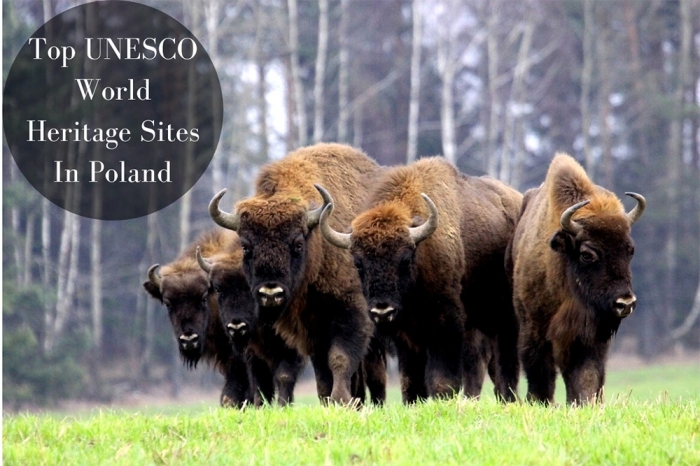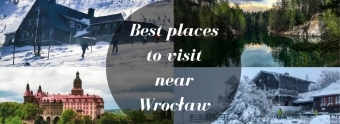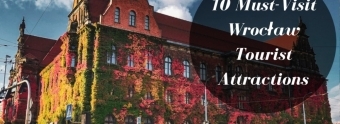Top UNESCO World Heritage Sites In Poland That Are A Must-Visit
July 1, 2022 by Amit Chandra
Poland, the Central European nation, is known for its captivating culture, heritage, and nature preserves. All the religious buildings from medieval times, the finest main market squares and churches exhibiting elegant victorian style are such a treat to the eyes. Some of these artistic masterpieces are among the top tourist attraction in Poland that every tourist must consider. The list of these finest creations is epitomised by UNESCO World Heritage Sites; the ultimate pride of Poland tourism.
These popular UNESCO World Heritage Sites are deeply rooted in Polish history and narrate tales from the past. While places like Auschwitz Birkenau recount the story of horrific times from the world war era, the historic centre of Warsaw is a mere illustration of human incredible ability to recover from the rubbles.
Let’s take a look at the top UNESCO World Heritage sites in Poland that uphold the country’s reputation globally.
Cultural UNESCO World Heritage Sites In Poland
1. Auschwitz Birkenau
Added to the list of UNESCO World Heritage Sites in 1979, Auschwitz-Birkenau was the largest and most dreadful of the six extermination camps in Poland operated by Nazi Germany primarily during 1942-44. The aim of the concentration camp was the mass murder of Jews.
The Auschwitz-Birkenau concentration camp in Poland attracts a large number of tourists to Poland, which was the place of torture and slaughter of Poles and Soviet prisoners of war. In addition to the aforementioned, Auschwitz also served as a camp for the racial murder of Roma and Sinti people, and other thousands of prisoners from Europe.
In addition to the mass murder of well over a million Jewish men, women and children, and tens of thousands of Polish victims, Auschwitz also served as a camp for the racial murder of thousands of Roma and Sinti and prisoners from several European nationalities.
Auschwitz-Birkenau concentration camp complexes were the ones which combined extermination with forced labour. The place paints a picture of extreme human exploitation and suffering. Consider it a must-do experience in Poland.
Find more details about the Auschwitz-Birkenau concentration camp on their official website here
How to reach Auschwitz-Birkenau
Auschwitz-Birkenau is well-connected with major Polish cities like Wrocław(2 hours 47 mins), Krakow(1 hour 25 mins), and Katowice (52 mins) by road. Oswiecim is the nearest train station, located 1.5 km from the site. It takes longer to reach here by train because of the change in connections.
2. Centennial Hall Wrocław (Hala Stulecia)
Photo courtesy: Whistling Hound
The Centennial Hall (Hala Stulecia) in Wrocław is a UNESCO recognised World Heritage Site and a leading tourist attraction in Wrocław. Built in 1911–1913 by the architect Max Berg, the Centennial Hall used to be a part of erstwhile Germany back in the day. Max Berg designed the Centennial Hall to be a multipurpose exhibition space hosting exhibitions, concerts, theatrical and opera performances, and sporting events.
Today, the Hala Stulecia in Wrocław is used for sporting events, business summits, and concerts. During the summer months, they organise a musical fountain dazzling with multicoloured lights at Hala Stulecia.
Photo courtesy: Whistling Hound
The Centennial Hall became one of Poland's official national Historic Monuments (Pomnik historii) in 2005, along with the other prominent attractions like the Four Domes Pavilion, the Pergola, and the Iglica. In 2006, the Centennial Hall was incorporated into the UNESCO World Heritage Site list.
How to reach Centennial Hall Wrocław
Centennial Hall is 3.5 km far from Rynek Wrocław. You can take a nice 35-40 min walk along the river crossing some scenic bridges and major Wrocław tourist attractions to reach Centennial Hall.
3. Churches of Peace in Jawor and Świdnica
Located in the towns of Jawor and Świdnica in southwestern Poland are the Churches of Peace - the largest timber-framed Baroque church in Europe. The Churches of Peace were built in the mid-17th century, adhering to the terms of the Peace of Westphalia, which concluded the Thirty Years’ War in 1648.
The Churches of Peace stands testimony to the toil for religious freedom and are a unique manifestation of Lutheran ideology in an idiom commonly associated with the Catholic Church. According to the treaty before the construction - the church had to be constructed using unstable materials, without a bell tower, and out of city premises.
The church's timber building exhibits the finest baroque architecture and interior. The exquisite baroque decorations on the altar, pulpit, polychrome on the ceiling and the organ make the Church of Peace a visual treat for tourists and a top tourist attraction in Poland. The church got included in the UNESCO world heritage list in 2001.
How to reach the Churches of Peace
The Churches of Peace in Świdnica is located 71 km far from the southwestern city of Wrocław and a straight 60-70 min drive from the city centre. Optionally, you can take a train from Wrocław main train station to Jawor train station.
4. Historic Centre of Kraków
Photo courtesy: Whistling Hound
The Historic Centre of Kraków is Poland’s top tourist attraction at its finest, boasting of the largest market square in Europe, covering numerous historical houses, palaces, churches, and other notable structures.
Take a lazy stroll down the Kraków Rynek (Main Market Square) to soak up the undying charm of Krakowian streets. The main market square dates back to the 13th century covering a staggering 9.4 acres in the heart of Kraków. The erstwhile capital of Poland, Kraków's terrific market square by the Royal Wawel Castle attracts millions of tourists worldwide.
Other fascinating things from the Historic Centre of Kraków worth mentioning are the remnants of the 14th-century fortifications, the medieval site of Kazimierz with its age-old synagogues in south Kraków, Jagellonian University, and the Gothic cathedral, the burial place for the kings of Poland.
Photo courtesy: Whistling Hound
How to reach the Historic Centre of Kraków
Kraków is well-connected to most of the prominent Polish and European cities by air, rail, and road. Krakow is located 267 km far from Wrocław, roughly 3 hours by road.
5. Historic Centre of Warsaw
The Historic Centre of Warsaw is an excellent example of human's extraordinary feats. The capital city of Poland, reduced to ruins (85% demolished) during the 1944 Warsaw Uprising, saw an unprecedented post-war reconstruction campaign led by Polish citizens that lasted 5 years. Polish administration took it upon themselves to meticulously restore the city's architecture covering the 13th to 20th centuries. The near-total reconstruction of the Historic Centre of Warsaw resulted in today's Old Town, churches, palaces and marketplace around it.
Some of the major tourist attractions in Warsaw city centre are the Royal Castle, St. John's Cathedral, the Barbican, Town Hall, Zygmunt’s Column, Statue of the Mermaid, and the Palace Square.
How to reach the Historic Centre of Warsaw
Warsaw city centre is located 10 km away from the most popular Chopin airport. There are plenty of options by public or private transport to get to the city’s Old Town.
Natural UNESCO World Heritage Sites In Poland
Let’s explore some of the top UNESCO World Heritage Sites that also make for top natural tourist attractions in Poland.
6. Ancient and Primaeval Beech Forests of the Carpathians
The Ancient and Primeval Beech Forests of the Carpathians, spread across the Carpathian Mountains in southeastern Poland, are among the last remaining indigenous forest type in diverse parts of Central and Eastern Europe. In July 2021, the UNESCO committee decided to include the Polish Beech Forest in the list.
A transnational property distributed in 94 parts across 18 European countries, Beech Forests have been dispersing since the Ice Age. Starting from a few isolated corners of Europe, the Beech forest has spread across the Alps, Carpathians, Dinarides, Mediterranean and Pyrenees and continues to expand. Thanks to the excellent adaptability of the trees and tolerance for different types of climate and geographical conditions.
The Polish part of the Beech forest is located in the Bieszczady Mountains, in the southeast corner of Poland. Bieszczady National Park is the third biggest national park in Poland, covering an area of almost 30,000 hectares. The national park region is home to some of the most exotic wildlife on earth like brown bears, wolves and lynx, and several predatory birds. The ancient and Primeval Beech Forests of the Carpathians are a top natural tourist attraction in Poland and other neighbouring countries.
How to reach the Beech Forests in the Bieszczady Mountains Poland
Some of the Polish cities in the vicinity of the Bieszczady Mountains are Rzeszow (144 km, 2-hour 40 min drive) Krakow (283 km, 4.5-hour drive) & Zakopane (307 km, 5-hour 15 min drive). Travelling by road is the most convenient way to be in the Polish mountains since public transport isn’t that reliable and efficient.
7. Białowieża Forest
Home to almost 800 European Bisons, the heaviest land animals on the continent, Białowieża Forest on the Poland-Belarus border is truly a nature paradise and a top tourist attraction in Poland. Comprising Białowieża Forest, Ladzka Forest, Świsłocka Forest and Szereszewska Forest, Białowieża Forest is a huge forest complex located in Eastern Poland.
The Forest complex is located on the water divide between Vistula and Neman rivers. Białowieża is also recognised as the last and most significant remaining part of the immense primaeval forest that once flourished on the European continent.
How to reach Białowieża Forest
Hajnówka town, located on the Poland-Belarus border, serves as the point of entry to the Białowieża Forest. Hajnówka is a 3-hour drive from Warsaw and has superb connectivity by rail and road. Warsaw Chopin Airport, the largest airport in the region, is located 220 km from the Bialowieza Forest.
Travelling to Hajnówka by car is the most hassle-free way of commuting. Buses ply from major cities like Warsaw and Białystok to Hajnówka. Moreover, you can take the cheapest and most efficient mode of transport like a train to reach Hajnówka train station 1 km from the forest. Trains are available from Warszawa Lotnisko Chopina (Warsaw Airport), Warszawa Zachodnia (Warsaw West), Warszawa Centralna (Central station), Warszawa Wschodnia (Warsaw East).
The true charm of Poland rests in these top UNESCO World Heritage Sites that are also among the most visited tourist attractions in the country. Make sure to include them in your itinerary if you’re planning to trip to Poland or Eastern Europe.
Should you have any queries related to the Tourism & Hospitality studies at the University of Wrocław or if you need general information about the city, please write to us on social media - Facebook, Instagram, or contact us via email.
Amit Chandra
Amit is a travel writer & founder of the blog Whistling Hound. A perpetual nature lover, Amit moved to Wrocław, Poland, three years ago. Ever since, he has been gallivanting around European countries, soaking up the best of places & sharing his experiences across digital media. From working as an Aurora Guide in Lapland to walking the streets of Naples & Rome like a local, Amit has done it all. Currently, he's treading through the best of southwestern Poland & is not stopping anytime soon!














































